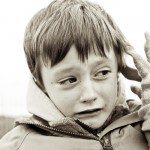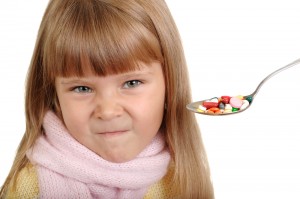
Do not use psychological debriefing when a child has been exposed to a traumatic event such as assault or a major car crash.
And if you treat a child who has developed Posttraumatic Stress Disorder (PTSD) due to trauma, do not use pharmacotherapy either (that is, not as a first line treatment).
Rather, apply the principles of psychological first aid in the direct aftermath of trauma and use trauma-focused cognitive behavioral therapy to treat PTSD.
These recommendations come from the brand new, very extensive Australian Guidelines for the Treatment of ASD and PTSD. For the first time, the guidelines include separate sections on children and adolescents.
How are the guidelines developed?
The guidelines are mainly informed by a systematic review of the literature and a staged process of expert consensus. People affected by trauma, clinicians and the public have also had varying levels of input.

This guidance does rely (in places) on expert opinion, which as we know, can be a biased form of evidence
A set of specific questions guided the systematic review. For example: “For people exposed to trauma, do early psychological interventions improve outcomes compared to no intervention?” followed by the question: “For people exposed to trauma, does any early psychological intervention confer any advantage over other early psychological interventions?”
Note that the systematic literature review only included Randomised Controlled Trials (RCTs). It did not consider ‘lower level evidence’. As you will see below, in many cases not enough scientific research was conducted to come to robust treatment conclusions. As a result, a significant part of the guidance relies on expert opinion.
Little certainty about what is best practice regarding children
The recommendations in the guidelines have several levels, depending on the strength of their support. This support is a combination of empirical evidence and expert opinion.
| Grade A | Body of evidence can be trusted to guide practice |
| Grade B | Body of evidence can be trusted to guide practice in most situations |
| Grade C | Body of evidence provides some support for recommendation(s) but care should be taken in its application |
| Grade D | Body of evidence is weak and recommendation(s) must be applied with caution |
| Consensus point | A research question was formulated for the systematic review but did not result in empirical data |
| Good practice point | The main developers decided not to ask a research question because they expected no (RCT) evidence to be available |
In total, 18 recommendations (grade A to D) were made, of which 7 for children. In addition, the guidelines contain 9 Consensus Points (1 for children) and 76 Good Practice Points (9 for children).
Of the recommendations regarding children, none is of level A and only one of level B: we still have a lot to unravel…
The most important lessons

The guideline recommends psychological first aid instead of psychological debriefing for children who have recently experienced a trauma
Rated ‘B’ is the recommendation that we should not offer psychological debriefing (e.g. a structured session that asks in depth about the experience and elated emotions) to children after a potentially traumatic event. The guidelines state that, in contrast, psychological first aid may be helpful, if mental health specialists are available for referrals.
Rated ‘C’ are three recommendations:
- For children with PTSD (from school age on), developmentally appropriate Trauma-Focused CBT should be considered
- Individual interventions should be considered in preference to group interventions
- When several children are exposed to the same event (e.g. a disaster), a school-based CBT intervention should be considered
The first recommendation may not be a surprise as trauma-focussed CBT has been the most studied trauma intervention for children. However, based on the meta-analysis by Rodenburg et al., I had expected to see Eye Movement Desensitization and Reprocessing (EMDR) as a recommendation as well. In contrast to the recent World Health Organisation (WHO) guidelines the Australian guidelines considered the evidence for EMDR not strong enough.
Although rated ‘C’, the recommendation to prefer individual interventions over group interventions seems to be weak. It appears to be based on two studies, one of which did not find an effect. The second study compared individual psychoanalytical psychotherapy to multi-session group therapy with psycho-education and psychotherapy elements for sexually abused girls, and reported better outcomes for the individual psychotherapy. However, the conditions differed on content, format, and number of sessions (up to 30 vs. up to 18), which makes it very difficult to come to conclusions. The WHO guidelines recommend both individual and group therapy.

The grade D evidence suggests that talking treatments should be tried before drug therapies for children with PTSD
Rated ‘D’ are a further three recommendations related to the use of pharmacotherapy with children and adolescents. The guidelines strongly convey the message that we should first try psychotherapy, in particular trauma-focussed CBT:
- Pharmacotherapy should not be used as a universal intervention to prevent PTSD in children
- Pharmacotherapy should not be used as a routine first treatment of PTSD in children
- Pharmacotherapy should not be used routinely as an adjunct to TF-CBT for children
General guidelines with regard to working with children after trauma
The ‘Good Practice Points’ provide some more general guidance on assessment and psychological care. For example:
- Asking whether a child has been exposed to trauma should be a routine part of any psychiatric assessment.
- When assessing PTSD symptoms, children and adolescents should be asked directly about their symptoms, separately from their parents.
- Parents may find it difficult to support their child due to their own stress reactions; clinicians should be aware of this and respond accordingly.
Links
Australian guidelines for the treatment of acute stress disorder and posttraumatic stress disorder. Australian Centre for Posttraumatic Mental Health, 2013.
The above website has a wealth of information and resources:
- The full guidelines (PDF)
- All appendices (PDF)
- PDF short guides for practitioners, parents, and child/youth-centered materials.

New Australian guidelines for the treatment of ASD and PTSD in children: Do not use psychological debriefing w… http://t.co/Ma4yAsXLKY
New Australian guidelines for the treatment of ASD and PTSD in children – The Mental Elf http://t.co/099qizJ52G
Talking treatments should be tried before drug therapies for children with PTSD, says new @ACPMH guidance http://t.co/aIARFK6nTt
Asking whether a child has been exposed to trauma should be a routine part of any psychiatric assessment http://t.co/aIARFK6nTt
@Mental_Elf i asked that question yesterday :) can be one of the keys to accessing talking therapies!
When assessing PTSD symptoms, children should be asked directly about their symptoms, separately from their parents http://t.co/aIARFK6nTt
Clinicians must recognise that parents may find it difficult to support their child due to their own stress reactions http://t.co/aIARFK6nTt
Try psychological first aid, not psychological debriefing for recently traumatised children, says new guidance http://t.co/aIARFK6nTt
New Australian guidelines for the treatment of ASD and PTSD in children http://t.co/oC1Tgu0H5h via @sharethis
@EvaAlisic blogs about the recent @ACPMH guidelines for the treatment of ASD and PTSD in children http://t.co/aIARFK6nTt
@ACPMH recommends trauma-focused CBT for school age children with PTSD http://t.co/aIARFK6nTt
@ACPMH say: When several children are exposed to the same event (eg a disaster) school-based CBT should be considered http://t.co/aIARFK6nTt
& again:New guidelines for the Rx of Acute Stress Disorder & Post-Traumatic Stress Disorder in children http://t.co/qhXVlT6UVW (@Mental_Elf)
@ACPMH say the evidence isn’t strong enough to recommend Eye Movement Desensitization and Reprocessing (EMDR) http://t.co/aIARFK6nTt
In case you missed it earlier: New guidelines for the treatment of ASD & PTSD in children http://t.co/aIARFK6nTt
Mental Elf: New Australian guidelines for the treatment of ASD and PTSD in children http://t.co/D3EEFYQM9j
New Australian guidelines for the treatment of ASD and PTSD in children http://t.co/jXELjneWg3